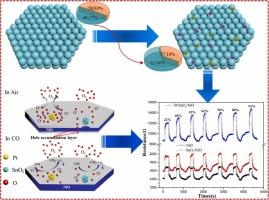Humidity-independent gas sensor based on Pt/SnO2/NiO with advanced CO sensing capabilities
IF 5.8
2区 材料科学
Q2 CHEMISTRY, PHYSICAL
引用次数: 0
Abstract
Aimed at realizing the sensors capable of functioning effectively in high-humidity environments, the Pt/SnO2/NiO ternary composite materials featuring noble metal and p-n heterojunction structures was synthesized. The dispersion of SnO2 and Pt nanoparticles on NiO nanosheets was found to be excellent, resulting in a nearly twofold increase (99.45 m2g-1 of Pt/SnO2/NiO) in specific surface area compared to pure NiO materials (51.977 m2g-1). The CO sensitivity tests revealed that, in contrast to pure NiO sensors (with an optimal operating temperature of 290°C), Pt/SnO2/NiO ternary composites exhibited an optimal operating temperature (OOT) of 270℃, a decrease of 20℃ for CO detection at a relative humidity of 22%. At this OOT, Pt/SnO2/NiO sensors consistently displayed high responsiveness (2.5 times higher than that of the pure NiO sensor), good selectivity, and rapid response-recovery times (the recovery time is reduced by nearly half compared to that of the pure NiO sensor). Furthermore, the sensors' responses to CO under different humidity conditions (from 22% to 91%) at 270℃ were investigated. The results demonstrated that Pt/SnO2/NiO sensors exhibited minimal variation in their response to CO at a range of relative humidity levels (41.5% at 91%, 39.5% at 22%, respectively). These results highlight that the enhancement of CO gas sensitivity in the sensors primarily results from the high catalytic activity of noble metal Pt and the p-n heterojunction interaction.

基于 Pt/SnO2/NiO 的不受湿度影响的气体传感器,具有先进的 CO 传感能力
为了实现能在高湿度环境下有效工作的传感器,合成了具有贵金属和 p-n 异质结结构的 Pt/SnO2/NiO 三元复合材料。研究发现,二氧化锡和铂纳米颗粒在镍氧化物纳米片上的分散性非常好,因此与纯镍氧化物材料(51.977 m2g-1)相比,铂/二氧化锡/镍氧化物的比表面积增加了近两倍(99.45 m2g-1)。一氧化碳灵敏度测试表明,与纯氧化镍传感器(最佳工作温度为 290℃)相比,Pt/SnO2/NiO 三元复合材料的最佳工作温度(OOT)为 270℃,在相对湿度为 22% 的条件下,一氧化碳检测温度降低了 20℃。在此最佳工作温度下,Pt/SnO2/NiO 传感器始终表现出较高的响应性(是纯 NiO 传感器的 2.5 倍)、良好的选择性和快速的响应-恢复时间(与纯 NiO 传感器相比,恢复时间缩短了近一半)。此外,还研究了传感器在 270℃、不同湿度条件(从 22% 到 91%)下对 CO 的响应。结果表明,Pt/SnO2/NiO 传感器在一系列相对湿度水平下对一氧化碳的响应变化极小(91% 时分别为 41.5%,22% 时分别为 39.5%)。这些结果突出表明,传感器对一氧化碳气体灵敏度的提高主要源于贵金属铂的高催化活性和 p-n 异质结的相互作用。
本文章由计算机程序翻译,如有差异,请以英文原文为准。
求助全文
约1分钟内获得全文
求助全文
来源期刊

Journal of Alloys and Compounds
工程技术-材料科学:综合
CiteScore
11.10
自引率
14.50%
发文量
5146
审稿时长
67 days
期刊介绍:
The Journal of Alloys and Compounds is intended to serve as an international medium for the publication of work on solid materials comprising compounds as well as alloys. Its great strength lies in the diversity of discipline which it encompasses, drawing together results from materials science, solid-state chemistry and physics.
 求助内容:
求助内容: 应助结果提醒方式:
应助结果提醒方式:


